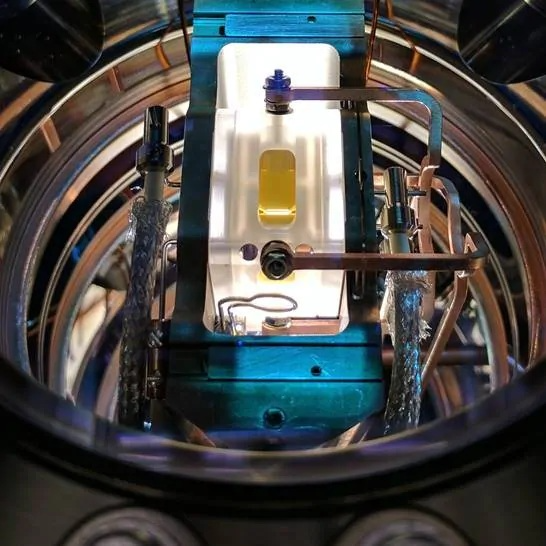Jun 17 2020
University of Sydney scientists have adapted methods from robotics and autonomous vehicles to efficiently evaluate the performance of quantum devices—a crucial process to help balance the emerging technologies.
 Ion trap in the Quantum Control Laboratory used in the experiment for the research. Image Credit: University of Sydney.
Ion trap in the Quantum Control Laboratory used in the experiment for the research. Image Credit: University of Sydney.
The new method has been experimentally demonstrated to supersede the simplistic characterization of these settings by a factor of three, with a relatively higher outcome for more complicated simulated settings.
Using this approach, we can map the ‘noise’ causing performance variations across quantum devices at least three times as quickly as a brute-force approach. Rapidly assessing the noise environment can help us improve the overall stability of quantum devices.
Riddhi Gupta, Study Lead Author and PhD Student, School of Physics, University of Sydney
The study has been published in Quantum Information—a Nature partner journal.
While quantum computing is still in its preliminary stages of development, it holds implications to redefine technologies by solving issues beyond the context of traditional computing.
One of the obstacles to produce these systems to practical scale is resolving the hardware imperfections. The rudimentary units of quantum technology—that is, quantum bits or qubits—are extremely responsive to disturbance from their settings such as electromagnetic “noise” and display performance changes that decrease their usefulness.
Ms Gupta, who is also a part of the ARC Centre of Excellence for Engineered Quantum Systems, has used methods from traditional estimation employed in robotics and modified them to enhance the performance of hardware. This was accomplished via the efficient automation of procedures that map both the performance changes and environment over massive quantum devices.
Our idea was to adapt algorithms used in robotics that map the environment and place an object relative to other objects in their estimated terrain. We effectively use some qubits in the device as sensors to help understand the classical terrain in which other qubits are processing information.
Riddhi Gupta, Study Lead Author and PhD Student, School of Physics, University of Sydney
In the field of robotics, machines depend on simultaneous localization and mapping, or SLAM for short, algorithms. Robotic vacuum cleaners are devices that constantly map their settings and then estimate their location inside that setting to move.
The problem with adapting SLAM algorithms to quantum systems is that if individuals define, or quantify, the performance of one qubit, they would damage its quantum data.
As such, Ms Gupta developed an adaptive algorithm that quantifies the performance of a single qubit and applies that data to predict the capabilities of neighboring qubits.
We have called this ‘Noise Mapping for Quantum Architectures’. Rather than estimate the classical environment for each and every qubit, we are able to automate the process, reducing the number of measurements and qubits required, which speeds up the whole process.
Riddhi Gupta, Study Lead Author and PhD Student, School of Physics, University of Sydney
Dr Cornelius Hempel, whose experimental group offered Ms Gupta data from experiments performed on a one-dimensional (1D) string of trapped ions, stated that he was happy to observe threefold enhancement even in the mapping of such a tiny quantum system.
“However, when Riddhi modelled this process in a larger and more complex system, the improvement in speed was as high as twentyfold. This is a great result given the future of quantum processing is in larger devices,” Dr Hempel added.
Professor Michael J. Biercuk, founder of quantum technology company Q-CTRL and director of the University of Sydney Quantum Control Laboratory in the Sydney Nanoscience Hub, is the supervisor of Ms Gupta.
“This work is an exciting demonstration that state-of-the-art knowledge in robotics can directly shape the future of quantum computing. This was a first step to unify concepts from these two fields, and we see a very bright future for the continued development of quantum control engineering,” Professor Biercuk concluded.
Declaration
The study was partly funded by the US Army Research Office, the ARC Centre of Excellence for Engineered Quantum Systems, and a private grant from H. & A. Harley.
Journal Reference:
Gupta, R. S., et al. (2020) Adaptive characterization of spatially inhomogeneous fields and errors in qubit registers. npj Quantum Information. doi.org/10.1038/s41534-020-0286-0.